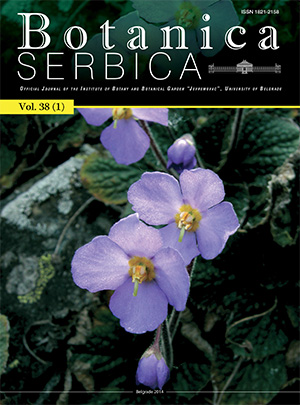
Volume 38 Issue 1 (GUEST EDITOR S. SILJAK-YAKOVLEV) 2014 |
Prof. Dr. Branka Stevanovic, on the occasion of her 70th birthday
|
|
Contribution to plant genome size knowledge: first assessments in five genera? and 30 species of angiosperms from western Balkans?
|
KEY WORDS: 2C-value, the Balkans, flow cytometry, nuclear DNA amount, vascular plants. |
Mitigation of plant drought stress in a changing climate
|
KEY WORDS: drought, deficit irrigation, resistance |
Is it possible to identify Colchicum neapolitanum s.l. and C. autumnale s.l. in vegetative stage?? Biometry and flow cytometry approaches
|
KEY WORDS: Balkan flora, biometry, Colchicum, flow cytometry, genome size |
New species for the vascular flora of Republic of Macedonia and their distribution in the Balkan Peninsula
|
KEY WORDS: vascular flora, new records, distribution ranges, Republic of Macedonia, Balkan Peninsula |
The aquatic resurrection plant Chamaegigas intrepidus – adaptation to multiple abiotic stresses and habitat isolation
|
KEY WORDS: poikilohydrous cormophytes, limnology, desiccation, gene flow, Namibia |
Chasmophytic communities of endemic and relict species Ramonda nathaliae Panc?ic´ & Petrovic´ on ophiolithic substrate in Republic of Macedonia?
|
KEY WORDS: Ramonda nathaliae, serpentine bedrock, chasmophytic communities, Balkans |
Morphological differences between the flowers of Ramonda serbica, R. nathaliae and their hybrid
|
KEY WORDS: Ramonda, Gesneriaceae, Balkan, sympatry, hybridization, morphometry. |
Plant growth regulators in bryophytes
|
KEY WORDS: bryophytes, mosses, liverworts, plant growth regulators, development |
Morpho-anatomical differentiation of the species Teucrium montanum (Lamiaceae) in the Central Balkan Peninsula
|
Descriptive statistics were performed for each of 28 continuous quantitative characters related to leaf and stem morphology and anatomy. The hypothesis of morphological separation of populations was tested using canonical discriminant analysis (CDA), and discriminant function analysis was used to estimate the contribution of individual characters to overall discrimination. The discrimination between groups in CDA was predominantly based on characteristics of the external structure on the leaf surface, while the internal structure of the leaf and stem did not show such significant differences between the 13 populations. The morpho-anatomical analysis of plants from these populations has confirmed that the species T. montanum belongs to evergreen microphyllic xeromorphic semi-bushes. Statistical analysis revealed four group of populations with significant morphological differentiation. One part of the observed anatomical variability could be explained as an adaptive response to different geographical and recent environmental factors, and another part seemed to be caused by genetic or evolutionary factors. KEY WORDS: Teucrium montanum, evergreen shrub, morphology, anatomy, indumentums, differentiation. |
Overview of the stoneworts (Charales) of Serbia with the estimation of the threat status
|
KEY WORDS: stonewort, Charales, Serbia, distribution, threat status |
GIS analysis of spatial distribution of invasive tree species in the protected natural area of Mt. Avala (Serbia)
|
KEY WORDS: invasive alien trees, GIS, protected area, Robinia pseudoacacia, Acer negundo |
Proteases and their endogenous inhibitors in the plant response to abiotic stress
|
KEY WORDS: protease, protease inhibitor, drought, salinity, cold, stress |
Chemical composition and antioxidant activity of two Satureja species from Mt. Biokovo
|
KEY WORDS: Satureja montana, Satureja cuneifolia, GC-MS, antioxidant activity. |
Chorological characterization and distribution of the Balkan endemic? vascular flora in Bosnia and Herzegovina
|
KEY WORDS: Bosnia and Herzegovina, Balkan endemic flora, chorological structure of flora, distribution of floristic elements. |
A simple and efficient DNA isolation method for Ornithogalum L. species (Hyacinthaceae, Asparagales)
|
KEY WORDS: Ornithogalum, DNA isolation, CTAB, phenol, PVPP, PCR. |
Open Access in Botany
|
KEY WORDS: Open Access, botany, e-publications |


